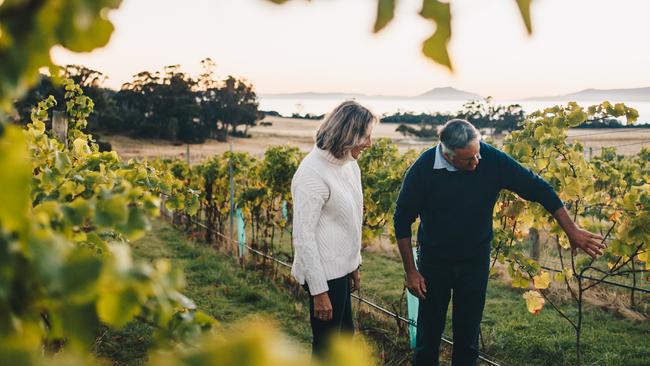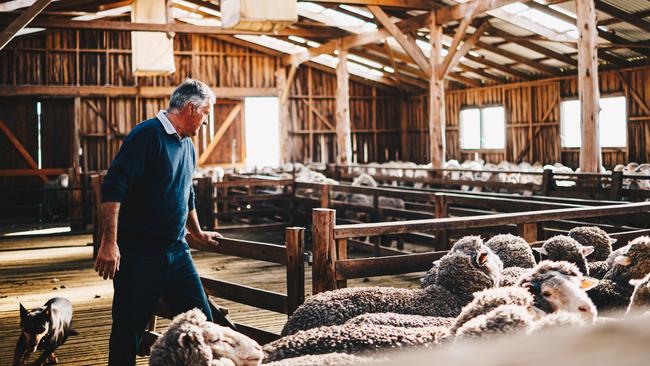Mayfield Estate: the balance between wool and wine
At first glance, there may not be too much connecting sheep and wine grapes, but this Tasmanian couple is finding the right balance.
At first glance, there may not be too much connecting sheep and wine grapes.
But for fifth-generation farmer Bruce Dunbabin, who with his partner, Jo Oliver, runs Mayfield Estate, branching out from the farm’s traditional superfine wool operation at Little Swanport, Tasmania, into small batch winemaking made for a perfect pairing.
And one that’s paid off in times of low yields and bad weather.
It’s a story of diversification, and seeking opportunities wherever they lie.
Since the 1840s, Bruce’s family has run Merino sheep, with Bruce owning about 2200ha of land and an additional 3000ha of leased country.
After multiple, devastating years of drought in the late 2000s Bruce sought to diversify his business in a bid to build resilience and profitability, no matter what the seasons were doing.
“The natural progression with the grapes was to value-add,” Bruce said.
In 2010 Bruce made the decision to diversify into wine.
“My brother went into grapes 15 years before that. He went into grapes with a contract. And I made a conscious decision to stay with the superfine Merinos, because it’s what I particularly like,” Bruce said.
“But that 2007 drought hit … I thought I have to do something else as well.”
During the drought, Bruce reduced his flock of about 6000 down to 2000.
“I still have all those sheep,” Bruce said.
“Superfine wool growing is still an important part of what we do.”

Mayfield Estate’s attention is split; 60 per cent superfine wool and 40 per cent grape production, producing about 20,000 bottles of wine last year – and as much as 50,000 in a good year – for the Mayfield Estate label.
Rain falls predominantly during winter at Mayfield Estate, averaging about 500mm a year, with “no obvious pattern in rainfall changes”.
This season, Bruce said, has been dry after two wet years, with the climate mild with no frost.
Mayfield Estate spans a flat landscape with some rolling bushland hills, with clay loam soils.
Growing primarily pinot noir and chardonnay grapes, recent vineyard plantings include pinot gris and shiraz, and have increased the size of the vineyard to nine hectares.
On the sheep side of the enterprise, Mayfield Estate this year is running 11,000 superfine Merinos.
Bruce initially planted five hectares of grapes – 2.5ha of pinot noir and 2.5 of chardonnay – for Hardy Wines after securing a 10-year contract.
“It was a very good contract,” Bruce said.
“They knew what the area could do, and had been at me for a couple of years to grow. Coming out of the drought was pretty devastating, so I took the contract to the bank and they said ‘how much money do you want?’. I was lucky to secure that contract.”
Hardy is now known as Accolade, and Mayfield Estate grapes, in a good year, are sold into Accolade’s Arras sparkling grand vintage range, retailing for about $120 a bottle.
Location of the vineyard, Bruce said, is key to the success of their grapes.
“We live on the coastline. We don’t have frost as a problem. It’s that maritime influence,” he said.
“It gives us a very long growing seasons. And the benefit of that is you’re able to really develop some exceptional flavours in the grapes. And if you’ve got exceptional flavour, you’ve got something you can work with. That will come out in quality of the wine.”
At the end of their contract in 2020, Bruce flagged with Accolade he wanted to do something else with the grapes he was producing.
“We had a good contract, but you’re still at the whim of their situation and are still price takers.”
What followed was a spot one-year contract where the company purchased any excess grapes not used in Mayfield’s own vintages.
“They’ve been very good to us and know what the grapes can do,” Bruce said.
“Prior to 2020, Jo and I thought about what would be nice to do together. And the natural thing to do was to add value.”
The next step, the couple decided, was to construct a cellar door: a place to interact with the public and to sell their own label wines.
“It gave me a job on farm,” Jo said.
“But I wasn’t lining up with the workmen every day, which I’ve done before.”
Bruce leaned on his brother for information and expertise, along with a cousin who has also run a cellar door since 2012.
“I was able to get really good information that you wouldn’t normally be able to get,” Bruce said.

Multiple elements of the Mayfield estate are timed to perfection, with one element to the farm sounding off right before the other.
The dual jobs of grape harvest and sheep shearing is a mental juggle, Bruce admits.
But it’s this diversity that keeps him, and his workers, stimulated and busy all year long.
Alongside Bruce and Jo works Bruce’s daughter Ellie and her partner, Alex, along with three additional employees.
“We flick between the wool growing operation and the vineyards … they never get stuck in a rut,” Bruce said.
The majority of the pastures are native grasses, with some improved pastures, which are predominantly rye-grass.
About 45 paddocks span the property, ranging in size from 4ha up to 200ha, with no cell grazing.
Some areas of bush are fenced off, Bruce said, but there are a number of wind breaks and native species plantations.
Two dams irrigate the property’s vines, along with a river water allocation.
Bruce said wages were the operation’s greatest expense, as hand picking and pruning, along with shearing expenses and chemicals accounted for much of the budget, which was planned two years in advance.
Minimal mechanics were used in the management of the vineyard, with much of the labour done by hand.
The biggest job is pruning throughout June each year, with 10 to 12 people on deck.
Harvest for the grapes starts in mid to late March and continues through to mid April.
“Through that period, we need to have the ewes crutched, which can be quite tight,” Bruce said.
“They need to be prepared, and that gives us a bit of a rush around to get those ewes prepared before grape harvest. Although we only pick for eight to nine days, we don’t really know when those days are.”
Shearing takes place in July, which is why Bruce aims to prune his vines in June “to get that out of the way”.
Shearing takes three weeks in July, before sheep are shorn again in September, and then in October.
“It’s a bit of juggling, and a bit of pressure.”
Last year, Bruce’s Merinos averaged 16.4 micron at shearing.
Genetics for the Mayfield Estate flock are sourced from the property’s own stud, with some interstate rams purchased.
Lambing takes place about the beginning of September, followed swiftly by bud burst.
This is followed by spraying, with the growth of the vines and wire lifting continuing throughout October until early December.
Spraying and grass slashing takes place throughout summer.
Harvest commences in March over a three to four-week period.
“It’s about nine to 10 days of hand picking, and that’s a logistic nightmare,” Bruce said.
“We pick with about 20 to 24 people, and finding people can be really tricky.”
Sourcing labour in recent years had been “a nightmare”, Bruce said.
But with more people travelling post-pandemic, backpackers have been returning to the Apple Isle, and are following the harvest across the island.
“Backpackers will pick cherries around Christmas, then move into grapes, and then apples,” Bruce said.
While the past two years’ average yield has been down at about two tonnes a hectare, in a good year the vines are capable of producing up to six tonnes a hectare.
“In a normal year we’d produce 40 to 50 tonnes, which we can easily use to sustain the cellar door,” Bruce said.
Scouting for opportunities in the future is central to the Mayfield Estate enterprise.
And Bruce and Jo have their sights set firmly on expansion, with plans to grow the vineyard to about 15ha, and potentially add accommodation.
The cellar door, which was opened last year, is one way the couple have diversified the business, with Bruce admitting yield in recent years had been so low cellar door sales was the only thing to keep the business profitable.
Jo said it had been a pleasant surprise how successful the enterprise had become.
Especially given the last couple of seasons, Bruce said.
“We’ve had a couple of years of production being down, with a couple of wet years,” Jo said.
“The last two production years have been seriously reduced. Almost to an uneconomic level, if we’d only been contract growing,” Bruce said.
“The cellar door came at a good time … I can’t think of how it could have gone any better.”





